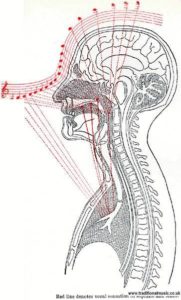Amplification (Resonation)
Amplification or Resonation is the boost of strength, support, and volume in every sound we make. Vocal ‘resonation’ can be thought of as vocal ‘acoustics’. Amplification is about how we create and enhance our vocal sound so that it can be heard clearly by our audience.
Have you ever thought about how your voice sounds in the bathroom or shower? Have you ever noticed the echoes we hear when we make loud noises around tall buildings? What does it sound like when you blow across the top of the neck of bottle when it contains different amounts of liquid? All these experiences exhibit what we can think of as “resonance”.

The tone quality of our voice or “timbre” depends on the strength of our breath support (actuation), vocal onset, and the placement of sound in our vocal resonating spaces or “sound chambers”. The sound chambers in our bodies are:
- Our chest and the spaces below our vocal chords which cannot be physically modified by singers
- The space just above our vocal chords and below our epiglottis called the ‘Pharynx’
- The spaces above our epiglottis into our nasal cavity and sinuses referred to commonly as the ‘Mask’
- And our mouths, which are our most changing resonator because of the way we constantly move our tongue and jaw during the act of singing
Let’s try a few exercises that will show us where to feel these sound chambers. We’ll start with the space just above our vocal chords and below our epiglottis.
- Begin a very slow and loose chewing movement, the way a cow chews. Do you notice the relaxing of the swallowing muscles in your throat? You should feel your tongue relaxing and a small space being created between each chew
- Immediately after we swallow, there should be a relaxing feeling of the swallowing muscles creating a small space that will help us open our sound as singers
- Inhaling very quickly as if we have been surprised will also create this space
For the sound chamber above our epiglottis try these exercises:
- Humming as if you just tasted your favorite desert is a good way to locate this area.
- Make high and low pitch sounds to feel the vibrations from your chest, all the way up to your head
- To let the sound out, try hooting like an owl at different pitches to get the full range of resonation throughout your body
- To put the sound right into your face to make sure that your vocal chords come all the way together for a balanced onset, and try to meow like a tiny kitten. To relax the vocal chords a bit more while placing your voice in the right place, try to meow like a full grown cat. Do you notice the difference?
Remember to always think of singing as the act of making sophisticated sounds. Thinking this way will help you remember how it feels to sing with the most ease. Good singing is the result of creating good physical habits by repeating them often. The best part is you don’t even have to sing all the time in order to create these good habits. Repeat the exercises above and make sure that you can achieve the physical feeling of each exercise so that you will recognize the feeling the next time you decide to sing.
